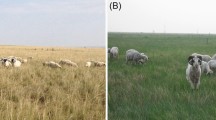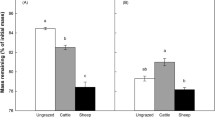Abstract
Herbivores are reported to slow down as well as enhance nutrient cycling in grasslands. These conflicting results may be explained by differences in herbivore type. In this study we focus on herbivore body size as a factor that causes differences in herbivore effects on N cycling. We used an exclosure set-up in a floodplain grassland grazed by cattle, rabbits and common voles, where we subsequently excluded cattle and rabbits. Exclusion of cattle lead to an increase in vole numbers and a 1.5-fold increase in net annual N mineralization at similar herbivore densities (corrected to metabolic weight). Timing and height of the mineralization peak in spring was the same in all treatments, but mineralization in the vole-grazed treatment showed a peak in autumn, when mineralization had already declined under cattle grazing. This mineralization peak in autumn coincides with a peak in vole density and high levels of N input through vole faeces at a fine-scale distribution, whereas under cattle grazing only a few patches receive all N and most experience net nutrient removal. The other parameters that we measured, which include potential N mineralization rates measured under standardized laboratory conditions and soil parameters, plant biomass and plant nutrient content measured in the field, were the same for all three grazing treatments and could therefore not cause the observed difference. When cows were excluded, more litter accumulated in the vegetation. The formation of this litter layer may have added to the higher mineralization rates under vole grazing, through enhanced nutrient return through litter or through modification of microclimate. We conclude that different-sized herbivores have different effects on N cycling within the same habitat. Exclusion of large herbivores resulted in increased N annual mineralization under small herbivore grazing.





Similar content being viewed by others
References
Aerts R, Chapin III FS (2000) The mineral nutrition of wild plants revisited: a re-evaluation of processes and patterns. Adv Ecol Res 30:1–67
Afzal M, Adams WA (1992) Heterogeneity of soil mineral nitrogen in pasture grazed by cattle. Soil Sci Soc Am J 56:1160–1166
Arsenault R, Owen-Smith N (2002) Facilitation versus competition in grazing herbivore assemblages. Oikos 97:313–318
Bakker JP, De Leeuw J, Van Wieren SE (1983) Micro-patterns in grassland vegetation created and sustained by sheep-grazing. Vegetatio 55:153–161
Bardgett RD, Wardle DA, Yeates GW (1998) Linking above-ground and below-ground interactions: how plant responses to foliar herbivory influence soil organisms. Soil Biol Biochem 30:1867–1878
Batzli GO, Pitelka FA (1970) Influence of meadow mouse populations on California grassland. Ecology 51:1027–1039
Batzli GO, Pitelka FA (1971) Condition and diet of cycling populations of the California vole, Microtus californicus. J Mammal 52:141–163
Bazely DR, Jefferies RL (1986) Changes in the composition and standing crop of salt-marsh communities in response to the removal of a grazer. J Ecol 74:693–706
Belovsky GE (1997) Optimal foraging and community structure: The allometry of herbivore food selection and competition. Evol Ecol 11:641–672
Boekhoff M (2000) The influence of herbivores on edaphic conditions in an extensively grazed riverine grassland. MSc thesis. Plant Ecology and Nature Conservation Group, Wageningen University, The Netherlands, pp 1–47
Brown JH (1995) Macroecology. The University of Chicago Press, Chicago, Ill.
Chesson A (1997) Plant degradation by ruminants: parallels with litter decomposition in soils. In: Cadisch G, Giller KE (eds) Driven by nature. Plant litter quality and decomposition. CAB International, Cambridge, pp 47–66
Day TA, Detling JK (1991) Grassland patch dynamics and herbivore grazing preference following urine deposition. Ecology 71:180–188
Demment MW, Van Soest PJ (1985) A nutritional explanation for body-size patterns of ruminant and nonruminant herbivores. Am Nat 125:641–672
Dijkstra C, Zijlstra M (1997) Reproduction of the Marsh Harrier Circus aeruginosus in recent land reclamations in The Netherlands. Ardea 85:37–50
Frank DA, Groffman PM (1998) Ungulate vs. landscape control of soil C and N processes in grasslands of Yellowstone National Park. Ecology 79:2229–2241
Frank DA, Groffman PM, Evans RD, Tracy BF (2000) Ungulate stimulation of nitrogen cycling and retention in Yellowstone Park grasslands. Oecologia 123:116–121
Frank DA, Kuns MM, Guido DR (2002) Consumer control of grassland plant production. Ecology 83:602–606
Hanski I, Henttonen H, Korpimakki E, Oksanen L, Turchin P (2001) Small-rodent dynamics and predation. Ecology 82:1505–1520
Haskell JP, Ritchie ME, Olff H (2002) Fractal geometry predicts varying body size scaling relationships for mammal and bird home ranges. Nature 418:527–530
Haynes RJ, Williams PH (1993) Nutrient cycling and soil fertility in the grazed pasture ecosystem. Adv Agron 49:119
Hobbs NT (1996) Modification of ecosystems by ungulates. J Wildl Manage 60:695–713
Holland EA, Detling JK (1990) Plant response to herbivory and belowground nitrogen cycling. Ecology 71:1040–1049
Huntly NJ (1991) Herbivores and the dynamics of communities and ecosystems. Annu Rev Ecol Syst 22:477–503
Jensen LS, McQueen DJ, Ross DJ, Tate KR (1996) Effects of soil compaction on N-mineralization and microbial-C and -N. II. Laboratory simulation. Soil Tillage Res 38:189–202
Kiehl K, Esselink P, Gettner S, Bakker JP (2001) The impact of sheep grazing on net mineralization rate in two temperate salt marshes. Plant Biol 3:553–560
Knops JMH, Bradley KL, Wedin DA (2002) Mechanisms of plant species impacts on ecosystem nitrogen cycling. Ecol Lett 5:454–466
Leutert A (1983) Einfluss der Feldmaus, Microtus arvalis (Pall.), auf die floristische Zusammenstellung von Wiesen-Oekosystemen. ETH, Zürich
Lockley RM (1962) Production of faecal pellets in the wild rabbit. Nature 194:988–989
Londo G (1976) The decimal scale for relevés of permanent quadrats. Vegetatio 33:61–64
McNaughton SJ, Banyikwa FF, McNaughton MM (1997) Promotion of the cycling of diet-enhancing nutrients by African grazers. Science 278:1798–1800
Milchunas DG, Lauenroth WK (1993) Quantitative effects of grazing on vegetation and soils over a global range of environments. Ecol Monogr 63:327–366
Olff H, Ritchie ME (1998) Effects of herbivores on grassland plant diversity. Trends Ecol Evol 13:261–265
Olofsson J, Oksanen L (2002) Role of litter decomposition for the increased primary production in areas heavily grazed by reindeer: a litter bag experiment. Oikos 96:507–515
Parton WJ, Schimel DS, Cole CV, Ojima DS (1987) Analysis of factors controlling soil organic matter levels in Great Plains grasslands. Soil Sci Soc Am J 51:1173–1179
Pastor J, Dewey B, Naiman RJ, McInnes PF, Cohen Y (1993) Moose browsing and soil fertility in the boreal forest of Isle Royale National Park. Ecology 74:467–480
Pastor J, Dewey B, Christian DP (1996) Carbon and nutrient mineralization and fungal spore composition of fecal pellets from voles in Minnesota. Ecography 19:52–61
Peters RH (1983) The ecological implications of body size. Cambridge University Press, Cambridge
Prins HHT, Olff H (1998) Species-richness of African grazer assemblages: towards a functional explanation. In: Newbery DM, Prins HHT, Brown ND (eds) Dynamics of tropical communities, 1st edn. BES, London, pp 449–490
Ritchie ME, Olff H (1999) Herbivore diversity and plant dynamics: compensatory and additive effects. In: Olff H, Brown VK, Drent RH (eds) Herbivores: between plants and predators. Blackwell, Oxford, pp 175–204
Ritchie ME, Tilman D, Knops JMH (1998) Herbivore effects on plant and nitrogen dynamics in Oak savanna. Ecology 79:165–177
Ruess RW, McNaughton SJ (1987) Grazing and the dynamics of nutrient and energy regulated microbial processes in the Serengeti grasslands. Oikos 49:101–110
Rustad LE Campbell JL, Marion GM, Norby RJ, Mitchell MJ, Hartley AE, Cornelissen JHC, Gurevitch J, GCTE-NEWS (2001) A meta-analysis of the response of soil respiration, net nitrogen mineralization, and aboveground plant growth to experimental ecosystem warming. Oecologia 126:543–562
Schaffers AP, Vesseur MC, Sykora KV (1998) Effects of delayed hay removal on the nutrient balance of roadside plant communities. J Appl Ecol 35:349–364
Sierra J (1997) Temperature and soil moisture dependence of N mineralization in intact soil cores. Soil Biol Biochem 29:1557–1563
Sirotnak JM, Huntly NJ (2000) Direct and indirect effects of herbivores on nitrogen dynamics: voles in riparian areas. Ecology 81:78–87
Tracy BF, Frank DA (1998) Herbivore influence on soil microbial biomass and nitrogen mineralization in a northern grassland ecosystem: Yellowstone National Park. Oecologia 114:556–562
Van der Wal R, Van Wijnen H, Van Wieren S, Beucher O, Bos D (2000) On facilitation between herbivores: how Brent geese profit from brown hares. Ecology 81:969–980
Van Wijnen H, Van der Wal R, Bakker JP (1999) The impact of herbivores on nitrogen mineralization rate: consequences for salt-marsh succession. Oecologia 118:225–231
Vitousek PM (1982) Nutrient cycling and nutrient use efficiency. Am Nat 119:553–572
Wallage-Drees JM (1988) Rabbits in the coastal sand dunes; weighed and counted. PhD thesis. University of Leiden, The Netherlands, pp 1–153
Wan S, Luo Y, Wallace LL (2002) Changes in microclimate induced by experimental warming and clipping in tallgrass prairie. Global Change Biol 8:754–768
Williams PH, Haynes RJ (1995) Effect of sheep, deer and cattle dung on herbage production and soil nutrient content. Grass Forage Sci 50:263–271
Willott SJ, Miller AJ, Incoll LD, Compton SG (2000) The contribution of rabbits (Oryctolagus cuniculus L.) to soil fertility in semi-arid Spain. Biol Fertil Soils 31:379–384
Young Owl MY, Batzli GO (1998) The integrated processing response of voles to fibre content of natural diets. Funct Ecol 12:4–13
Acknowledgements
We are grateful to Wouter van Steenis and Wendy Schuurman for their help during biomass harvests. Ernst Adam, Hajo Molegraaf, Wouter van Steenis, Julia Stahl and Chris Bakker helped with vole trapping. We thank the Staatsbosbeheer for permission to work on Junner Koeland. Jan van Walsem is acknowledged for his help with the laboratory analyses. We thank John Pastor and an anonymous reviewer for their comments on an earlier version of this manuscript. This study was performed with a grant from NWO-ALW (no. 805–35–391).
Author information
Authors and Affiliations
Corresponding author
Rights and permissions
About this article
Cite this article
Bakker, E.S., Olff, H., Boekhoff, M. et al. Impact of herbivores on nitrogen cycling: contrasting effects of small and large species. Oecologia 138, 91–101 (2004). https://doi.org/10.1007/s00442-003-1402-5
Received:
Accepted:
Published:
Issue Date:
DOI: https://doi.org/10.1007/s00442-003-1402-5




